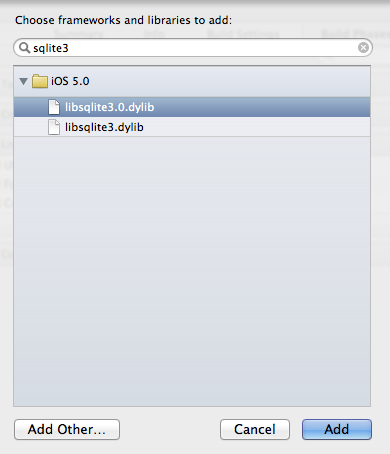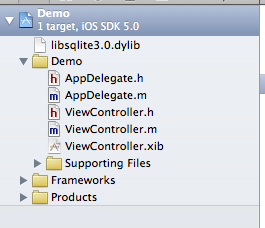iOS App項目中引入SQLite數據庫的教程
引入SQLite
sqlite是純C實現的,所以注定了它是一個跨平台利器,在Android與IOS下均能使用,而且完全可以寫出通用的代碼,方便我們移植。當然Android和IOS下都有封裝過的sqlite給開發者使用,不過這樣子一個是不方便移植,另一個是封裝後的效率咋樣我們也不知道,所以還是原生態的最健康。最後一個重要的原因就是原生的使用也是相當簡單。我將在接下來的教程中為您一一講解。
首先最重要的一點是在工程中導入sqlite,蘋果的SDK已經給你包含進來了,所以只要導入一個叫 libsqlite3.0.dylib 的 framework就好了。然後,包含相應的頭文件:#import "sqlite3.h" 。
在IOS工程的導入就已經結束了,你可以正常使用了。
在其他工程中,比如android中,嵌入式linux中,我們就需要添加兩個文件了 請到 http://sqlite.org/download.html 下載相應的文件,你用哪個平台的就對應下哪個文件,不過我一般下第一個叫做 sqlite-amalgamation-3071000.zip 的文件,這個裡面包含了一個 sqlite3.c 與一個 sqlite3.h 。我直接把這兩個文件拖到我的工程中去,然後在需要使用的地方把 .h 文件包含進來就好了 。這樣比調用編譯好的庫的好處是我能更方便的調試,我也能對他的功能做一些修改,比如我可以自己在裡面添加一套 自己的加密方式,又或者我可以添加幾個回調函數來方便與上層交互。或者刪掉我們不需要的功能,減少代碼冗余。
在我接下來的講解中,我會用純C去講解,雖然我會在蘋果的 xcode 環境下去寫代碼,但是除了庫的引用方式不一樣以外,其他的都一樣,我會盡量避免與平台相關的東西。當然有時候我可能會寫一個有UI的Demo,這時候就無可避免地要與平台打交道了,不過這個教程的關鍵點在於弄懂底層的原理,學會sqlite的API的調用,根據自己的需求封裝以及提供接口。
最後附上xcode 中導入sqlite的圖:

單擊那個加號。然後搜索sqlite3 ,選取 sqlite3.0.dylib, 然後 單擊Add。然後你就看到工程中這個庫導進來了。


然後在需要調用的地方導入頭文件:

SQLite的數據類型
要使用數據庫你得先弄清楚他的數據類型,不是嗎?sqlite 數據類型及其簡單:
- NULL. 空值
- INTEGER. 整型
- REAL.浮點型
- TEXT.文本類型
- BLOB. 二進制類型,用來存儲文件,比如圖片。
以上是sqlite的存儲類型,當然,每種類型會根據數據長度有不同的子類型。這個現在不講, 因為你可以直接使用上述這些大的類型。你知道知道有哪幾個類型就好了。以後在實際運用中慢慢熟悉就好了 。
sqlite其實沒有強制要求你預先聲明數據類型,在實際存儲過程中它會根據實際類型來自動轉換,不過為了提高效率我們不建議non-datatype。
下面附上一個創建表的代碼,主要是讓你體會一下數據類型的實際運用:
CREATE TABLE student( name TEXT, //姓名 no INTEGER, //學號 totalScore REAL, //總分 photo BLOB //照片 );
句柄的定義
要操縱一個數據庫你就得有一個這個數據庫的句柄(又碰到這個難以理解的詞了,不過確實還沒得一個更好的詞來替代它)。其實你跟本不需要去在乎這個詞叫什麼,你只要搞清楚他是一個什麼玩意兒。就如同鞋子為什麼叫鞋子,仔細想想確實也難以理解,不過 清楚他的功能就OK了,不是嗎?
句柄在很多地方我們見到過,最常見的就是文件的句柄,我們要操縱一個文件,我們就要取得一個文件的句柄。句柄是個什麼東東呢?其實很簡單,句柄是一個東東的描述,他被定義為一個結構體,這個結構體可能會包含要描述的東東的具體信息,比如位置、大小、類型等等。我們有了這個描述信息我們就能去找到這個東東,然後操縱它。
一句話:句柄是物體的描述結構體。
我們來看看sqlite的句柄是怎麼定義的(不要被嚇到了,代碼直接跳過就好):
struct sqlite3 {
sqlite3_vfs *pVfs; /* OS Interface */
int nDb; /* Number of backends currently in use */
Db *aDb; /* All backends */
int flags; /* Miscellaneous flags. See below */
unsigned int openFlags; /* Flags passed to sqlite3_vfs.xOpen() */
int errCode; /* Most recent error code (SQLITE_*) */
int errMask; /* & result codes with this before returning */
u8 autoCommit; /* The auto-commit flag. */
u8 temp_store; /* 1: file 2: memory 0: default */
u8 mallocFailed; /* True if we have seen a malloc failure */
u8 dfltLockMode; /* Default locking-mode for attached dbs */
signed char nextAutovac; /* Autovac setting after VACUUM if >=0 */
u8 suppressErr; /* Do not issue error messages if true */
u8 vtabOnConflict; /* Value to return for s3_vtab_on_conflict() */
int nextPagesize; /* Pagesize after VACUUM if >0 */
int nTable; /* Number of tables in the database */
CollSeq *pDfltColl; /* The default collating sequence (BINARY) */
i64 lastRowid; /* ROWID of most recent insert (see above) */
u32 magic; /* Magic number for detect library misuse */
int nChange; /* Value returned by sqlite3_changes() */
int nTotalChange; /* Value returned by sqlite3_total_changes() */
sqlite3_mutex *mutex; /* Connection mutex */
int aLimit[SQLITE_N_LIMIT]; /* Limits */
struct sqlite3InitInfo { /* Information used during initialization */
int iDb; /* When back is being initialized */
int newTnum; /* Rootpage of table being initialized */
u8 busy; /* TRUE if currently initializing */
u8 orphanTrigger; /* Last statement is orphaned TEMP trigger */
} init;
int nExtension; /* Number of loaded extensions */
void **aExtension; /* Array of shared library handles */
struct Vdbe *pVdbe; /* List of active virtual machines */
int activeVdbeCnt; /* Number of VDBEs currently executing */
int writeVdbeCnt; /* Number of active VDBEs that are writing */
int vdbeExecCnt; /* Number of nested calls to VdbeExec() */
void (*xTrace)(void*,const char*); /* Trace function */
void *pTraceArg; /* Argument to the trace function */
void (*xProfile)(void*,const char*,u64); /* Profiling function */
void *pProfileArg; /* Argument to profile function */
void *pCommitArg; /* Argument to xCommitCallback() */
int (*xCommitCallback)(void*); /* Invoked at every commit. */
void *pRollbackArg; /* Argument to xRollbackCallback() */
void (*xRollbackCallback)(void*); /* Invoked at every commit. */
void *pUpdateArg;
void (*xUpdateCallback)(void*,int, const char*,const char*,sqlite_int64);
#ifndef SQLITE_OMIT_WAL
int (*xWalCallback)(void *, sqlite3 *, const char *, int);
void *pWalArg;
#endif
void(*xCollNeeded)(void*,sqlite3*,int eTextRep,const char*);
void(*xCollNeeded16)(void*,sqlite3*,int eTextRep,const void*);
void *pCollNeededArg;
sqlite3_value *pErr; /* Most recent error message */
char *zErrMsg; /* Most recent error message (UTF-8 encoded) */
char *zErrMsg16; /* Most recent error message (UTF-16 encoded) */
union {
volatile int isInterrupted; /* True if sqlite3_interrupt has been called */
double notUsed1; /* Spacer */
} u1;
Lookaside lookaside; /* Lookaside malloc configuration */
#ifndef SQLITE_OMIT_AUTHORIZATION
int (*xAuth)(void*,int,const char*,const char*,const char*,const char*);
/* Access authorization function */
void *pAuthArg; /* 1st argument to the access auth function */
#endif
#ifndef SQLITE_OMIT_PROGRESS_CALLBACK
int (*xProgress)(void *); /* The progress callback */
void *pProgressArg; /* Argument to the progress callback */
int nProgressOps; /* Number of opcodes for progress callback */
#endif
#ifndef SQLITE_OMIT_VIRTUALTABLE
Hash aModule; /* populated by sqlite3_create_module() */
VtabCtx *pVtabCtx; /* Context for active vtab connect/create */
VTable **aVTrans; /* Virtual tables with open transactions */
int nVTrans; /* Allocated size of aVTrans */
VTable *pDisconnect; /* Disconnect these in next sqlite3_prepare() */
#endif
FuncDefHash aFunc; /* Hash table of connection functions */
Hash aCollSeq; /* All collating sequences */
BusyHandler busyHandler; /* Busy callback */
int busyTimeout; /* Busy handler timeout, in msec */
Db aDbStatic[2]; /* Static space for the 2 default backends */
Savepoint *pSavepoint; /* List of active savepoints */
int nSavepoint; /* Number of non-transaction savepoints */
int nStatement; /* Number of nested statement-transactions */
u8 isTransactionSavepoint; /* True if the outermost savepoint is a TS */
i64 nDeferredCons; /* Net deferred constraints this transaction. */
int *pnBytesFreed; /* If not NULL, increment this in DbFree() */
#ifdef SQLITE_ENABLE_UNLOCK_NOTIFY
/* The following variables are all protected by the STATIC_MASTER
** mutex, not by sqlite3.mutex. They are used by code in notify.c.
**
** When X.pUnlockConnection==Y, that means that X is waiting for Y to
** unlock so that it can proceed.
**
** When X.pBlockingConnection==Y, that means that something that X tried
** tried to do recently failed with an SQLITE_LOCKED error due to locks
** held by Y.
*/
sqlite3 *pBlockingConnection; /* Connection that caused SQLITE_LOCKED */
sqlite3 *pUnlockConnection; /* Connection to watch for unlock */
void *pUnlockArg; /* Argument to xUnlockNotify */
void (*xUnlockNotify)(void **, int); /* Unlock notify callback */
sqlite3 *pNextBlocked; /* Next in list of all blocked connections */
#endif
};
typedef struct sqlite3 sqlite3;//
是不是被嚇到了,沒關系,這段代碼本來就是我貼出來嚇唬你的,我也沒認真研究過這個代碼,也不想去研究,除非哪天有人出高價請我去研究,我現在只知道怎麼用就好了。
這個 sqlite3 結構體就是被用來描述我們磁盤裡的數據庫文件的,有了這個描述符我們就可以對這個數據庫進行各種操作了,操作的具體內情我們不必要了解,我們只需要知道怎麼去調用API就好了,當然有時候還是要了解一點點內情的,這個以後碰到再講。
我用這麼長的話加一大段嚇人的代碼只有一個目的:不要對句柄有恐懼感。
好了,開始我們的正題,sqlite 裡面你要操縱數據庫我們先得創建一個句柄,然後後面所有對數據庫得操作都會用到這個句柄。
sqlite3* pdb;
就 這麼簡單,這樣一個ssqlite的句柄我們就創建完成了,我們以後針對數據庫的操作都離不開它了。




